

© Shipping Wonders of the World 2012-

The Convoy System
The protection of food supply ships is always of paramount importance to a nation at war. The convoy system in various forms has been adopted for this purpose by almost every maritime nation since sea transport began
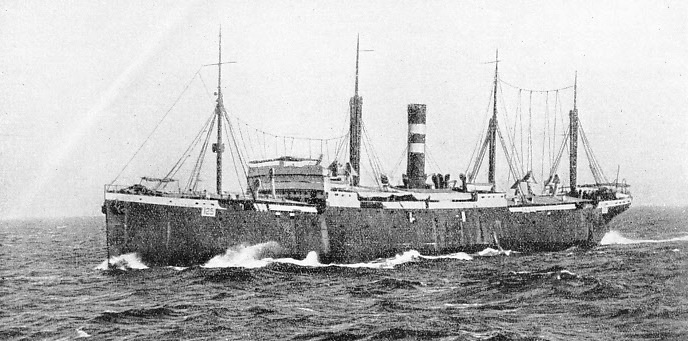
IN THE RED SEA transports were often compelled to break out of their convoy in a following wind if they were carrying horses. Parting from a convoy is normally a serious offence, but it was sometimes necessary. The Huntsman, for instance, illustrated above, carried an Indian Lancer regiment on board in 1914. To force enough air for the horses down into the holds it was necessary to turn about and steam head to wind for a time.
TO the average citizen, the duty of convoying is, perhaps, the primary duty of a Navy. Although the fear of invasion may some-
The origin of the convoy system is lost in the mists of history. It is certain that the Romans had some such system for bringing to Rome the fleets that carried tribute corn through the pirate-
The handicap to the use of the Cinque Ports’ ships was that they were only bound for a certain period every year. In 1372 Edward III was forced to order that ships convoying the wine fleet should be paid two shillings for every tun of wine that was brought safely to port. Any profit that the convoys had made by trading or by capturing enemy vessels was to be deducted from this. In that year the wine convoys consisted of five ships and one “barge” from Bayonne, France, to England and ten ships and four “barges” from England to Bayonne.
As warships began to develop apart from armed merchantmen, they undertook convoy duties and instituted a measure of control that was not always as acceptable to the merchants. There were, however, not nearly enough warships for the purpose, and the Navy was constantly forced to fall back on private ships hired and armed. In 1513 the owner of the Mawdelin of Hull received £55 (a large sum in those days) for escorting the fleet to Calais.
The duty of convoying and the task of keeping some sort of station in company were among the principal reasons for the introduction of the ship rig. For many years the largest vessels, although they were known as ships in contrast to the smaller vessels that were all called barques, were almost invariably barque-
During the Commonwealth, Cromwell paid much more attention to the protection of British commerce than had been usual before his day. He also took strong measures to have the flag properly respected abroad, whether it was worn by merchantmen or men-
A large number of merchant ships were hired and armed by the Commonwealth Navy. The Admiralty also paid far greater attention to the design of the smaller types of warship. Although originally prompted largely for the protection of merchantmen, this move was later of the greatest benefit to the Navy itself.
After Cromwell’s day the French made the attack of British commerce the keystone of their naval policy. The British fleet was almost invariably superior to theirs, but they fully realized that the Merchant Service was the Achilles’ Heel of the country and could be attacked to our embarrassment and their profit. The great race of French privateers then started, and ships were specially designed for the purpose in all the principal French bases. High speeds were aimed at in a time when speed was considered of little importance at sea.
Although the French naval officers were jealous and contemptuous of these corsairs, the authorities fully realized their value. When there were any suitable men-
In League with the Enemy
This naturally caused more attention to be given to convoying. In 1695 and 1703 the shipping and marine insurance interests of Britain succeeded in forcing an unwilling government to establish special trade defence squadrons, consisting of ships that were practically taken out of the hands of the Admiralty and were not to be available for any other purpose. In 1742 it was complained in the House of Commons that vessels trading with Portugal had been detained in port for nearly twelve months for lack of escort. A Bill on the lines of the previous measures was thrown out only with great difficulty by the Admiralty. In 1743 a French fleet in the English Channel caused West Indian trade to be interrupted from April to November. While the Admiralty was fighting the demands of the majority of the better-
To check these practices, a number of convoy laws was passed. The most important of these convoy laws was passed in 1798. It was enacted that no ship was to leave a British port without convoy under penalty of a thousand pounds fine. To pay for the service extra Customs duties were levied on certain imports and exports and a variable tonnage duty was paid by all merchant ships, ranging from sixpence a ton burthen for the vessels going to Ireland to three shillings a ton on East Indiamen.
The convoy system was not generally popular, however, even among the most reputable shipowners. Delays in collecting ships at the terminal ports and in keeping station with the slowest sailers in the fleet meant an enormous waste of time and money. In addition, the average merchantman did not want to have any more to do with the Navy than was necessary because of the activities of the press gang. On many occasions when the king’s ships had seen the merchantmen free from the danger of enemy attack, they laid them open to danger from marine risk by robbing them of all their best men.
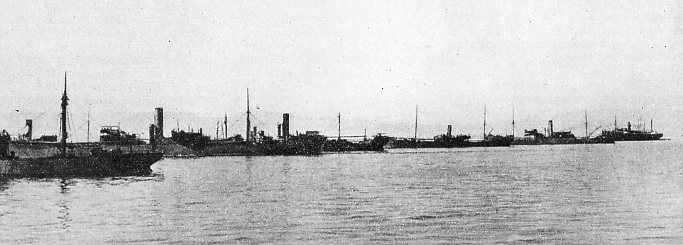
ASSEMBLING OFF GIBRALTAR IN 1918. Convoys consisting of many types of vessel were formed to ensure the safe transit of the food supply ships upon which the lives of all inhabitants of Great Britain depended during the war of 1914-
One way of evading these disadvantages was to take out a privateer’s commission, or Letters of Marque, for the privateers were naturally permitted to sail without convoy. For this reason almost all the big East Indiamen were given privateers’ commissions. The Court of Directors would have been upset if their East Indiamen had gone out of their way in search of prizes. The privateers’ commission, however, permitted the East Indiamen to fire first without being in danger of having their officers hanged for piracy. Although the commission permitted the ships to sail as and when they wished, they usually took advantage of convoy protection.
The marine insurance interests were among the keenest advocates of the convoy system. They were the principal sufferers by enemy wars on commerce, and when the dashing American privateers operated close to British ports Lloyd’s had to quote as much as twelve guineas per cent and more to cover their risk, even for the short voyage between Liverpool and Ireland. They were always willing to reduce their premiums when the owners would consent to sail in convoy, and often they had to make the policy altogether void for ships that neglected this precaution.
Convoy work was unpopular in the Navy. A particularly gallant defence of a convoy, however, would often secure a jewelled sword and large monetary reward from Lloyd’s. Ships of all types were used -
Handiness and speed were necessary above all things, but a good measure of power was a great advantage. The 74-
The ships of that day included every rig under the sun, their speed and handiness varied considerably, and the uncoppered ships would get so foul that they could scarcely move through the water. The difficulty of organizing and sailing a convoy with such diverse vessels was enormous. If this heterogeneous collection of ships were sailed in close company there was always a big risk of collision. If they were given proper sea room the convoy would be so spread out that proper protection was practically impossible. One convoy in 1794 consisted of 600 sail escorted by three dozen men-
With such an ungainly charge, and with the difficulty of putting about in a hurry big ships of the line, it is not surprising that the smartest naval officers were liable to lose a good many ships. Some vessels would straggle, and on many occasions smart privateers or small warships, British as well as enemy, would watch their chance and cut out ships from the flanks of the fleet under the very guns of their escorts.
At the end of the Napoleonic Wars the Admiralty still maintained convoy services in some waters, particularly in the Levant, where ports still offered a home for innumerable pirates. Under the Treaty of Paris that ended the Crimean War, it was definitely laid down that “privateering is and remains abolished”, and many people thought that the convoy system was obsolete and would never be revived.
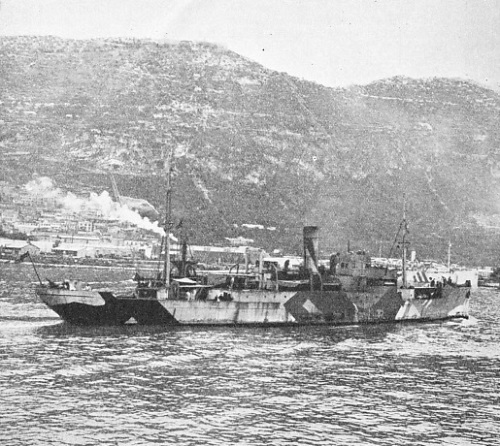
A CONVOY SLOOP of the Aubretia class specially built for convoy work during the war of 1914-
The Russian Volunteer Fleet was founded after the British Navy had prevented Russia taking Constantinople in the Russo-
On the outbreak of war in 1914 the question again demanded consideration. Convoys were provided for the big transport fleets from India, Africa, Canada and Australia, but they were a big drain on the naval resources of the country. For the protection of commerce, as well as of the cross-
In the early days of the war the shipowners were quite complacent in the matter. They feared above all things delays in sailing and congestion at the ports. It was not until the unrestricted submarine campaign was opened that there was a popular clamour for convoy protection. The Admiralty was not then prepared to grant it. Although the Navy then possessed far more destroyers
than it does to-
Naval men who had been trained in station-
The Danger Zone
This experiment was so successful that in a few weeks it was decided to repeat it on a larger scale in the late spring of 1917. Seventeen ships coming from Gibraltar in convoy all arrived safely, and of a dozen vessels that crossed the Atlantic from Hampton Roads, all full of war material, the only ship sunk was one that dropped out of her place and tried to make her way independently.
The fear that the merchant officer could not keep station was removed for all time. The instructions given were vague, but in a short time the Merchant Service understood all that was necessary and carried out instructions with remarkable efficiency. By July 1917 munition and food ships from the North American ports were sailing regularly in convoy, and by the following month the outward ships were doing the same. The building of the necessary types of minor men-
Against surface attack the convoys presented a narrow front and big depth; against submarines a broad front and shallow depth were demanded. Decoy ships often sailed with a convoy, pretending to be stragglers in the hope that they would tempt an enemy submarine. Normally, ships over 16 knots in speed sailed independently and relied on their speed to escape trouble. Convoys with speeds between 12½ and 16 knots were classed as “fast”, and those between 8 and 12½ knots as “slow”.
The Navy had to depend largely on the speed given by the merchant ships’ men, and that was unreliable. Sometimes difficulties of speed were due to bad coal, for ships had to pick up what bunkers they could in wartime. The periodical cleaning of fires was also a difficulty in keeping the ships in proper formation, but generally the work was magnificently done.
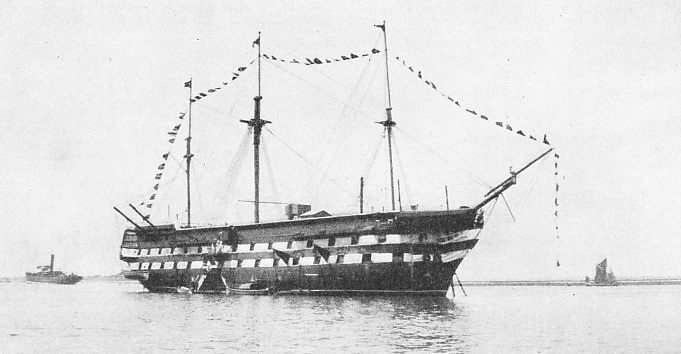
A TWO-
The condition of the trade lanes from Scandinavia presented special difficulties, not only because they were so handy to the German submarines and the ships of their High Seas Fleet, but also because their Navy was dealing with neutral vessels. There was a fear that neutrals would withdraw their tonnage rather than risk having it sunk.
Towards the end of 1916, when there had been some heavy casualties on the Scandinavian trade, the system of protected sailings was inaugurated before the actual convoys were introduced. Local forces from the Orkneys and Shetlands, backed by any small craft that could be spared by the Grand Fleet at Scapa Flow, patrolled whichever route was being used; but the moment the French convoys had proved their utility the system was extended to the Scandinavian trade. The neutrality of these ships made the proper organization and handling of the convoys difficult.
Conditions were not improved by two disasters that befell the Scandinavian convoy. In October 1917 it consisted of twelve ships, escorted by H.M. destroyers Stronqbow and Mary Rose. It was suddenly attacked by two of the latest German fast cruisers, and although the destroyers put up a gallant fight, they were sunk with nine of the merchantmen under their charge. Two months later a second convoy of six steamers, escorted by H.M. destroyers Pellew and Partridge and four trawlers, was attacked by a German destroyer flotilla, and all but H.M.S. Pellew were sunk. After these disasters the convoying force was strengthened, and at the end of the war even battleships were used, although they were obviously in grave danger from torpedo attack. H.M. battleship Commonwealth, obsolete for service with the Grand Fleet, was fitted with anti-
The success of the operation caused more and more demand for escorting warships. Sloops, fine sea-
New Convoying Sloops
The Grand Fleet spared a number of destroyers which, having high speed, proved invaluable for convoying through the most dangerous waters inshore. Despite their small size and lack of speed the trawlers, with their crews of fishermen, did magnificent work. To prevent the convoy from being held up and endangering all the ships in it if one of the convoy was hit, rescue tugs went with the other vessels to render immediate assistance. Some of these tugs were commissioned from the merchant fleet, but their number was insufficient and the Saint class was built specially for the purpose.
In addition, the Royal Air Force used airships, seaplanes and kite balloons, which started aloft when the convoy was forming and helped it through the danger zone. These observation facilities were of the greatest value, but when the convoy was a slow one it was difficult for the observers to keep close to it.
When the radius of action of the German submarines increased, the convoy system was extended, but it was difficult to find naval material to carry out the duties. The difficulty was partly overcome by using armed merchantmen for ocean escorts.
Some of these were passenger vessels, but the greater part were the faster cargo ships armed with 6-
During the war of 1914-
The British Navy in 1936 had further types of convoying sloop under construction. The Bittern type, of about 1,190 tons, is armed with four 4·7-
Most foreign Powers have favoured a type that has all the elements of a destroyer on a small scale. These ships are bound to be more fragile than the British sloops and have a far smaller radius of action, but on the other hand they are much faster, and it must be remembered that the destroyer has already proved herself in practice to be the most effective convoying vessel.
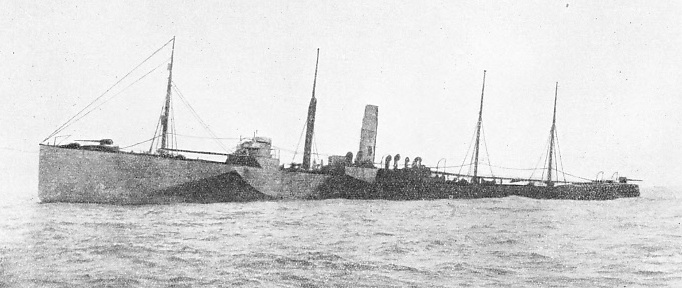
AN ARMED ESCORT SHIP fitted out for convoy duty during the war of 1914-
You can read more on “Auxiliary Ships”, “The Royal Naval Volunteer Reserve” and “Troopships and Trooping” on this website.